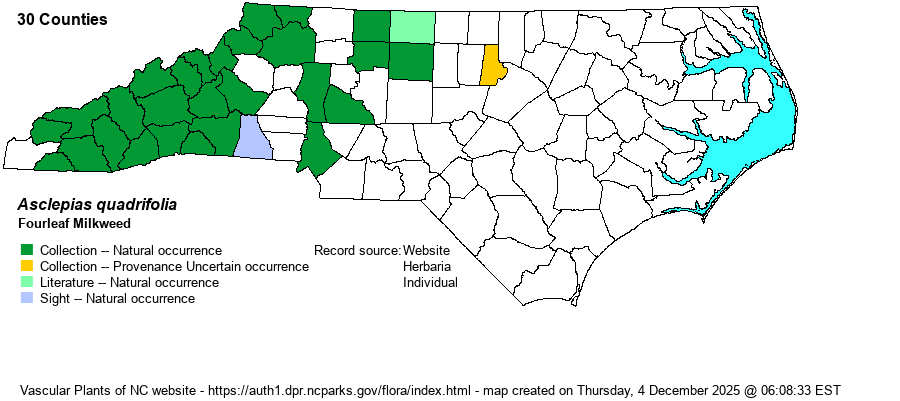| Author | Jacquin | |
| Distribution | Throughout the Mountains; scattered in the western Piedmont, mainly in foothills ranges. Apparently now extirpated from the central Piedmont, and the record for Durham County, a century or more ago, must be treated as of uncertain provenance.
This is a somewhat northerly species, ranging from New England west to IN, and south mainly along the Appalachians to central GA, the FL Panhandle, and eastern TX. | |
| Abundance | Fairly common in the Mountains, though much less numerous there than the other mostly montane species -- Poke Milkweed (A. exaltata). It is rare to uncommon in the western Piedmont, where clearly declining in recent decades -- at least along the eastern part of the range. | |
| Habitat | This milkweed occurs in mesic hardwood forests, as well as in openings and edges, and it shows a preference for somewhat high pH (circumneutral) soils. It does not normally occur in Rich Cove Forests, but is more often found in Basic Oak-Hickory Forests, other oak-hickory forests, or in Northern Hardwood Forests. As with most milkweeds, it tends to be found more often along roadbanks and woodland edges than in deep shade. |
| Phenology | Blooms in May and June, and fruits in August and September. | |
| Identification | Compared with many milkweeds, this is a rather small and somewhat dainty one, growing only to about 1.5 feet tall. It is different from all others in the genus in that its paired leaves are actually "double-paired" in the middle of the stem. That is, the upper and lower pairs of leaves are opposite, but the several pairs of leaves in the middle of the stem are actually in whorls of 4 leaves. These mid-stem leaves are ovate to lanceolate, about 3-4 inches long and half as wide, with tapering tips. The upper leaves are somewhat smaller. There are a few small flower clusters (umbels) from the top of the stem and upper axils, each being hemispherical and about 1.5 inches across. The flowers are fairly densely packed and are usually pale lavender to pink, but can also be whitish. This species, when seen in leaf, should be identifiable, as long as the several sets of 4 whorled leaves (with noticeable petioles) are clearly present. Of course, when in bloom, it is unmistakable. It does normally grow in scattered patches, but considering its wide potential of habitats, it does not seem as common as it should be, perhaps owing to some affinity toward drier circumneutral soil. | |
| Taxonomic Comments | None
| |
| Other Common Name(s) | Whorled Milkweed | |
| State Rank | S4 | |
| Global Rank | G5 | |
| State Status | | |
| US Status | | |
| USACE-agcp | | |
| USACE-emp | | |

